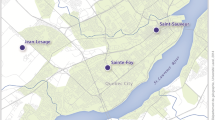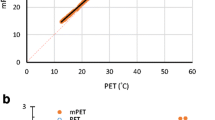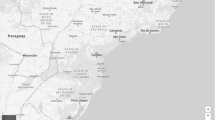Abstract
In human biometeorology, the integration of several microclimatic variables as a combined index facilitates the understanding of how users perceive thermal environments. Indices, such as the physiological equivalent temperature (PET) index, translate the combined effects of meteorological variables on humans in terms of thermal stress or comfort and serve as important aids to climate-responsive urban and regional planning as well as heat stress and thermal comfort analyses. However, there is a need for adjusting proposed comfort/stress ranges of a given index when using it in different climatic contexts. The purpose of this study is to present a preliminary calibration procedure for the PET index for three different climatic regions: Curitiba, Brazil, a subtropical location; Rio de Janeiro, Brazil, a tropical city; and Glasgow, UK, a high-latitude location. Field studies have been carried out by the authors according to a similar protocol and using similar equipment, yielding actual thermal sensation votes and microclimate data, post-processed as PET data. The calibration procedure uses exclusively thermal sensation data as reported by pedestrians during outdoor comfort campaigns and concurrent microclimatic data recorded during the interviews. PET comfort/stress classes differ among the three locations and, in general, are less restrictive as in the original ranges proposed by the index developers.








Similar content being viewed by others
Notes
From weather files available at https://energyplus.net/weather. Weather data for Glasgow are assumed as at the nearest weather station in Oban, 56° 25′ N, 5° 28′ W, 4 m a.s.l (note that the ASHRAE classification shown here is derived algorithmically from the source weather data. It may not be indicative of the long-term climate for each location).
References
ASHRAE (2004a) Standard 90.2-2004, Energy-Efficient Design of Low-Rise Residential Buildings. American Society of Heating, Refrigerating, and Air-Conditioning Engineers, Atlanta
ASHRAE (2004b) Standard 55-2004, Thermal environmental conditions for human occupancy. American Society of Heating, Refrigerating, and Air-Conditioning Engineers, Atlanta
da Silva FT, de Alvarez CE (2015) An integrated approach for ventilation's assessment on outdoor thermal comfort. Build Environ 87:59–71
de Dear RJ, Fountain ME (1994) Thermal comfort in air conditioned office buildings in the tropics. Journal of the Australian Institute of Refrigerating, Air-Conditioning and Heating 48(9):14–30
Fanger PO (1970) Thermal comfort. Analysis and applications in environmental engineering. McGraw Book Company, New York
Hirashima SQS, Assis ES, Nikolopoulou M (2016) Daytime thermal comfort in urban spaces: a field study in Brazil. Build Environ 107:245–253
Hirashima S, Katzschner A, Ferreira D, Assis ES, Katzschner L (2015) Thermal comfort comparison and evaluation in different climates Toulouse, França. Proceedings of ICUC 9—The 9th International Conference on Urban Climate. Toulouse, France
Honjo T (2009) Thermal comfort in outdoor environment. Global Environmental Research 13:43–47
Höppe P (1984) Die Energiebilanz des Menschen. München Universitäts Schriften, Fachbereich Physic, Wissenschaftliche Mitteilungen 49
Höppe P (1993) La température physiologiquement équivalente—PET: heat balance modelling. Experientia 49:741–746
Höppe P (1999) The physiological equivalent temperature—a universal index for the biometeorological assessment of the thermal environment. Int J Biometeorol 43:71–75
INSTITUTO BRASILEIRO DE GEOGRAFIA E ESTATÍSTICA—IBGE (2010) Censo Demográfico 2010. Características gerais da população. Rio de Janeiro: IBGE, 2012. Accessed: http://censo2010.ibge.gov.br, Dec 2016
ISO 10551 (1995) Ergonomics of the thermal environment—assessment of the influence of the thermal environment using subjective judgement scales. International Organisation for Standardisation, Geneva
ISO 7726 (1998) Ergonomics of the thermal environment—instruments for measuring physical quantities. International Organisation for Standardisation, Geneva
ISO 7730 (1994) Moderate thermal environments—determination of the PMV and PPD indices and specification of the conditions for thermal comfort. International Organisation for Standardisation, Geneva
ISO 8996 (2004) Ergonomics of the thermal environment—determination of metabolic rate. International Organisation for Standardisation, Geneva
ISO 9920 (2007) Ergonomics of the thermal environment—estimation of thermal insulation and water vapour resistance of a clothing ensemble. International Organisation for Standardisation, Geneva
Johansson E, Emmanuel R (2006) The influence of urban design on outdoor thermal comfort in the hot, humid city of Colombo, Sri Lanka. Int J Biometeorol 51(2):119–133
Johansson E, Thorsson S, Emmanuel R, Krüger E (2014) Instruments and methods in outdoor thermal comfort studies-the need for standardization. Urban Climate 10:346–366
Kántor N, Kovács A, Takács Á (2016) Seasonal differences in the subjective assessment of outdoor thermal conditions and the impact of analysis techniques on the obtained results. Int J Biometeorol 60(11):1615–1635
Knez I (2005) Attachment and identity as related to a place and its perceived climate. J Environ Psychol 25(2):207–218
Knez I, Thorsson S (2006) Influences of culture and environmental attitude on thermal, emotional and perceptual evaluations of a public square. Int J Biometeorol 50(5):258–268
Knez I, Thorsson S (2008) Thermal, emotional and perceptual evaluations of a park: cross-cultural and environmental attitude comparisons. Build Environ 43(9):1483–1490
Kovács A, Unger J, Gál CV, Kántor N (2015) Adjustment of the thermal component of two tourism climatological assessment tools using thermal perception and preference surveys from Hungary. Theor Appl Climatol 125:113–130
Krüger E, Drach P, Bröde P (2015) Implications of air-conditioning use on thermal perception in open spaces: a field study in downtown Rio de Janeiro. Build Environ 94:417–425
Lai D, Guo D, Hou Y, Lin C, Chen Q (2014) Studies of outdoor thermal comfort in northern China. Build Environ 77:110–118
Lin TP, Matzarakis A (2008) Tourism climate and thermal comfort in Sun Moon Lake, Taiwan. Int J Biometeorol 52:281–290
Lucchese JR, Mikuri LP, de Freitas NV, Andreasi WA (2016) Application of selected indices on outdoor thermal comfort assessment in Midwest Brazil. Journal homepage: www.IJEE.IEEFoundation.org 7(4):291–302
Makaremi N, Salleh E, Jaafar MZ, Ghaffarianhoseini AH (2011) Thermal comfort conditions of shaded outdoor spaces in hot and humid climate of Malaysia. Build Environ 48:7–14
Matzarakis A, Mayer H (1996) Another kind of environmental stress: thermal stress. WHO newsletter 18:7–10
Matzarakis A, Blazejczyk K, Amelung B (2007) Climate change and tourism assessment and coping strategies. Maastricht-Warsaw-Freiburg. ISBN, 978-900. http://www.urbanclimate.net/matzarakis/papers/Book_Nato.pdf
Matzarakis A, Rutz F, Mayer H (2010) Modelling radiation fluxes in simple and complex environments: basics of the RayMan model. Int J Biometeorol 54:131–139
Monteiro LM, Alucci MP (2006) Calibration of outdoor thermal comfort models. Proceedings of PLEA2006—The 23rd Conference on Passive and Low Energy Architecture. Geneva, Switzerland
National Records of Scotland (NRS) (2011) Scotland’s Census 2011. Accessed: http://www.scotlandscensus.gov.uk. Dec 2016
Pantavou K, Santamouris M, Asimakopoulos D, Theoharatos G (2014) Empirical calibration of thermal indices in an urban outdoor Mediterranean environment. Build Environ 80:283–292
Prata-Shimomura AR, Monteiro LM, Frota AB (2009) Physiological equivalent temperature index applied to wind tunnel erosion technique pictures for the assessment of pedestrian thermal comfort. Proceedings of the 7th International Conference on Urban Climate. Yokohama, Japan
Salata F, Golasi I, de Lieto Vollaro R, de Lieto Vollaro A (2016) Outdoor thermal comfort in the Mediterranean area. A transversal study in Rome, Italy. Build Environ 96:46–61
Thorsson S, Honjo T, Lindberg F, Eliasson I, Lim EM (2007) Thermal comfort and outdoor activity in Japanese urban public and places. Environ Behav 39:660–684
VDI (2008): VDI 3787. Environmental meteorology. Methods for the human biometeorological evaluation of climate and air quality for urban and regional planning at regional level. Part I: Climate, Blatt 2/ Part 2
Zacharias J, Stathopoulos T, Wu H (2001) Microclimate and downtown open space activity. Environ Behav 33(2):296–315
Author information
Authors and Affiliations
Corresponding author
Rights and permissions
About this article
Cite this article
Krüger, E., Rossi, F. & Drach, P. Calibration of the physiological equivalent temperature index for three different climatic regions. Int J Biometeorol 61, 1323–1336 (2017). https://doi.org/10.1007/s00484-017-1310-8
Received:
Revised:
Accepted:
Published:
Issue Date:
DOI: https://doi.org/10.1007/s00484-017-1310-8




